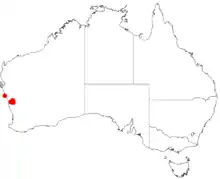Acacia lanceolata
Acacia lanceolata[2] is a shrub belonging to the genus Acacia and the subgenus Phyllodineae and is endemic to a small area of western Australia.
| Acacia lanceolata | |
|---|---|
| Scientific classification | |
| Kingdom: | Plantae |
| Clade: | Tracheophytes |
| Clade: | Angiosperms |
| Clade: | Eudicots |
| Clade: | Rosids |
| Order: | Fabales |
| Family: | Fabaceae |
| Clade: | Mimosoideae |
| Genus: | Acacia |
| Species: | A. lanceolata |
| Binomial name | |
| Acacia lanceolata | |
 | |
| Acacia lanceolata occurrence data from Australasian Virtual Herbarium[1] | |
Description
The open pungent shrub typically grows to a height of 0.3 to 1.2 metres (1.0 to 3.9 ft).[3] It usually has many branches with spinose, hairy branchlets that are covered with a fine white powdery coating at the extremities and have stipules on new shoots. Like most species of Acacia it has phyllodes rather than true leaves. The evergreen, pungent phyllodes have an inequilateral to lanceolate shape but are also occasionally narrowly elliptic. The glabrous to sparsely haired phyllodes are 7 to 15 mm (0.28 to 0.59 in) in length anf 1.5 to 4 mm (0.059 to 0.157 in) wide and have a central midrib central and two or three parallel minor nerves. When it blooms it produces simple inflorescences with single headed racemes with an axis that is less than 0.5 mm (0.020 in) in length. the spherical to shortly obloid flower-heads contain 20 to 23 golden coloured flowers. Following flowering it will produced seed pods that resemble a string of beads. The glabrous and firmly chartaceous pods are often quite tightly coiled with a length up to 17 mm (0.67 in) and a width of around 10 mm (0.39 in). The seeds inside are arranged longitudinally inside and have an oblong-elliptic shape with a length of around 4 mm (0.16 in).[4]
Taxonomy
The species was first formally described by the botanist Bruce Maslin in 1999 as a part of the work Acacia miscellany. The taxonomy of fifty-five species of Acacia, primarily Western Australian, in section Phyllodineae (Leguminosae: Mimosoideae) as published in the journal Nuytsia. It was reclassified as Racosperma lanceolatum in 2003 then transferred back to genus Acacia in 2006.[5]
Distribution
It is native to an area along the west coast of the Wheatbelt and Mid West regions of Western Australia where it is commonly situated on breakaways and lateritic hills in between the towns of Mingenew in the north west, Morawa in the north east and Three Springs in the south.[3] It is usually a part of either open Eucalyptus woodland or tall Casuarina shrubland communities.[4]
See also
References
- "DOI Details". doi.ala.org.au. doi:10.26197/5c0b1388984eb. Retrieved 8 December 2018.
- Acacia lanceolata Maslin
- "Acacia lanceolata". FloraBase. Western Australian Government Department of Parks and Wildlife.
- "Acacia lanceolata". World Wide Wattle. CSIRO Publishing. Retrieved 29 June 2020.
- "Acacia lanceolata Maslin". Atlas of Living Australia. Global Biodiversity Information Facility. Retrieved 29 June 2020.
